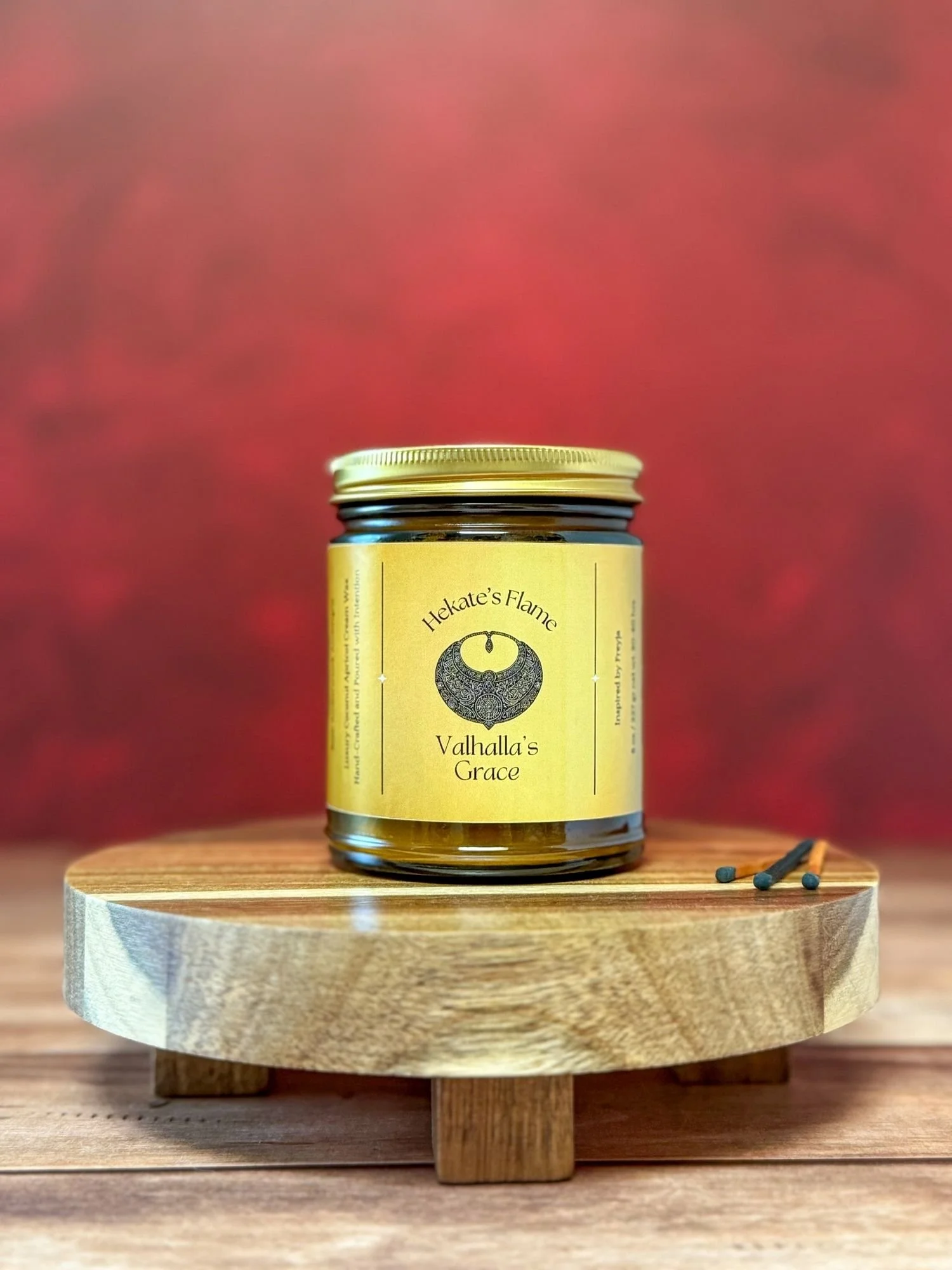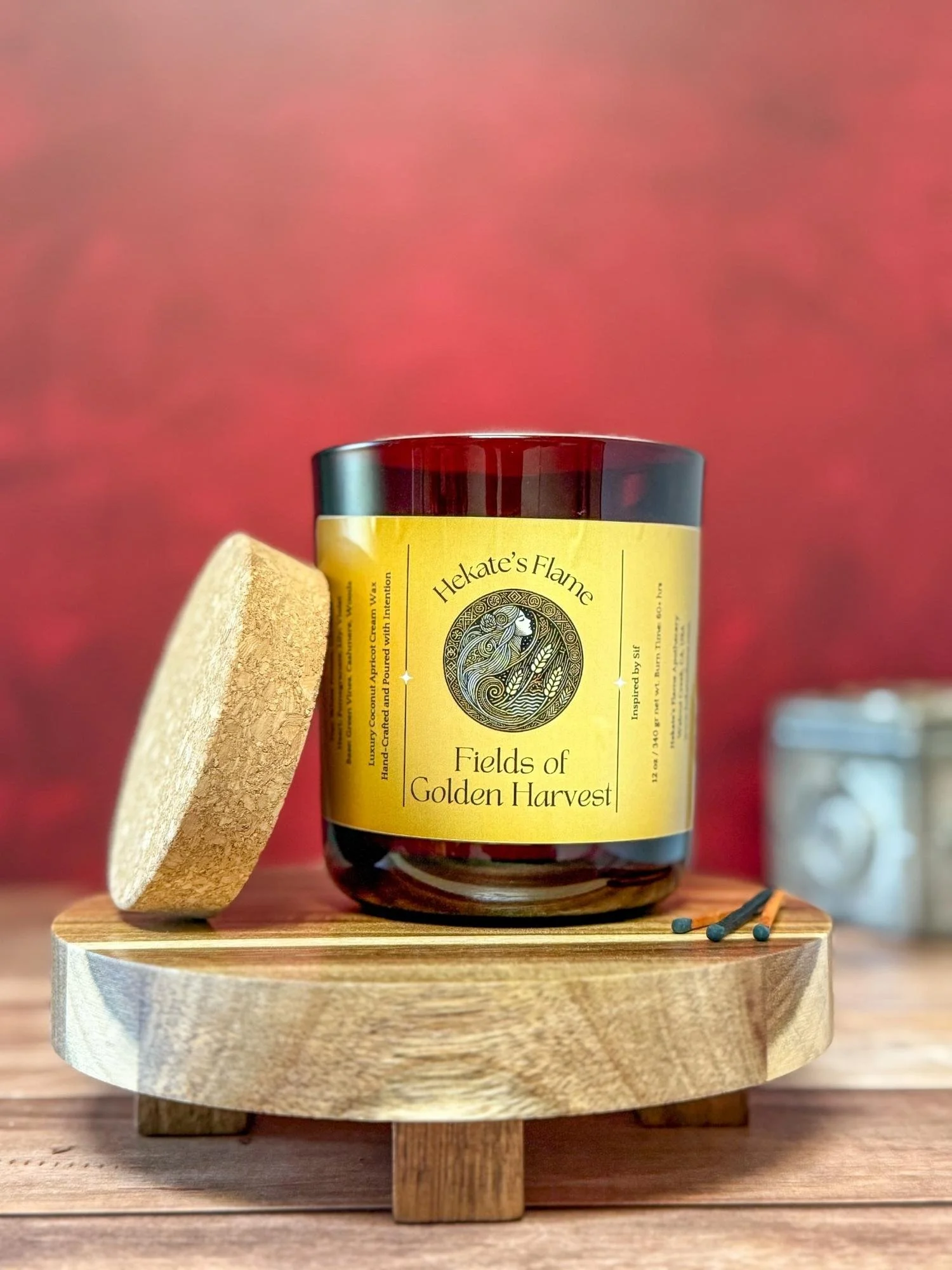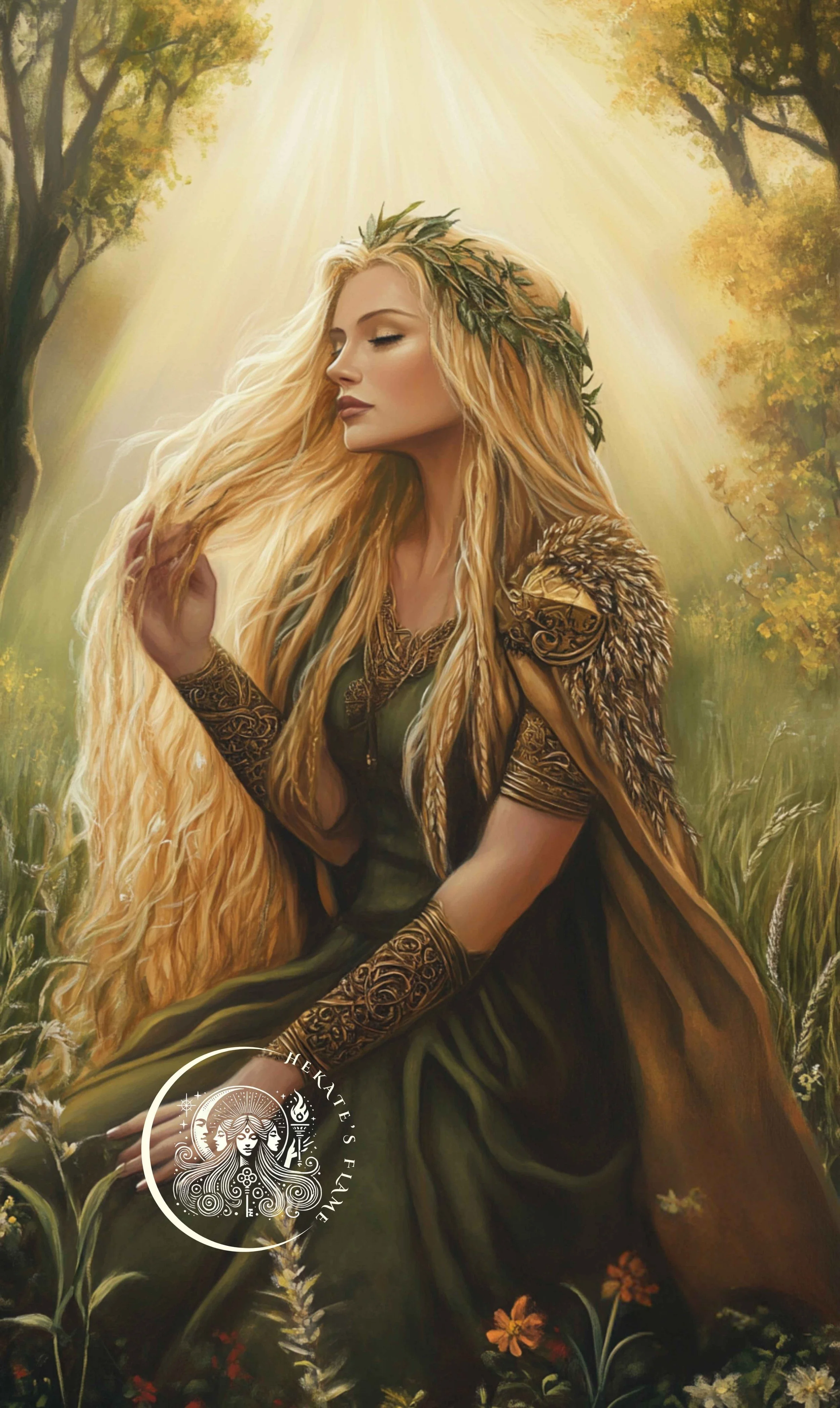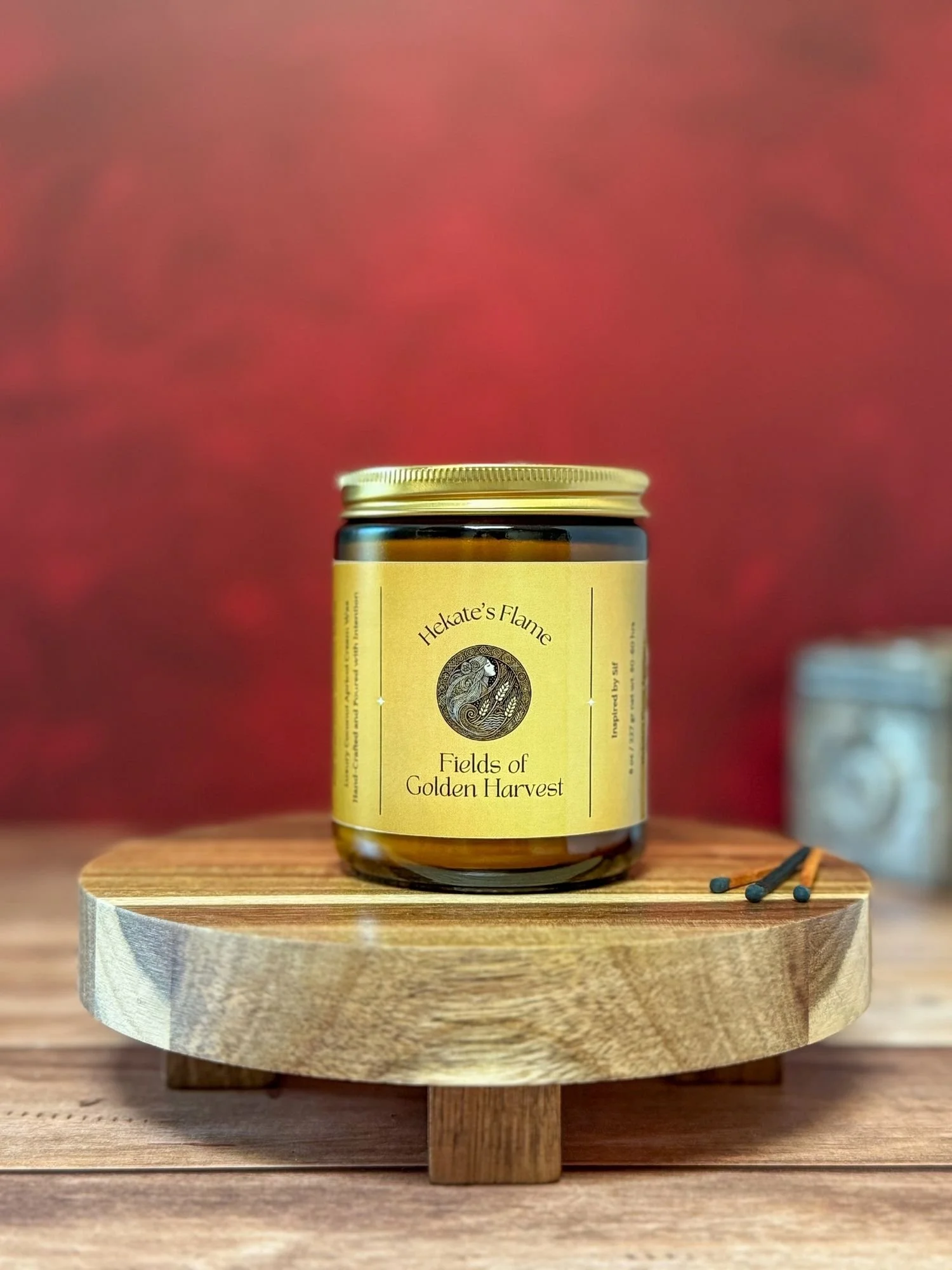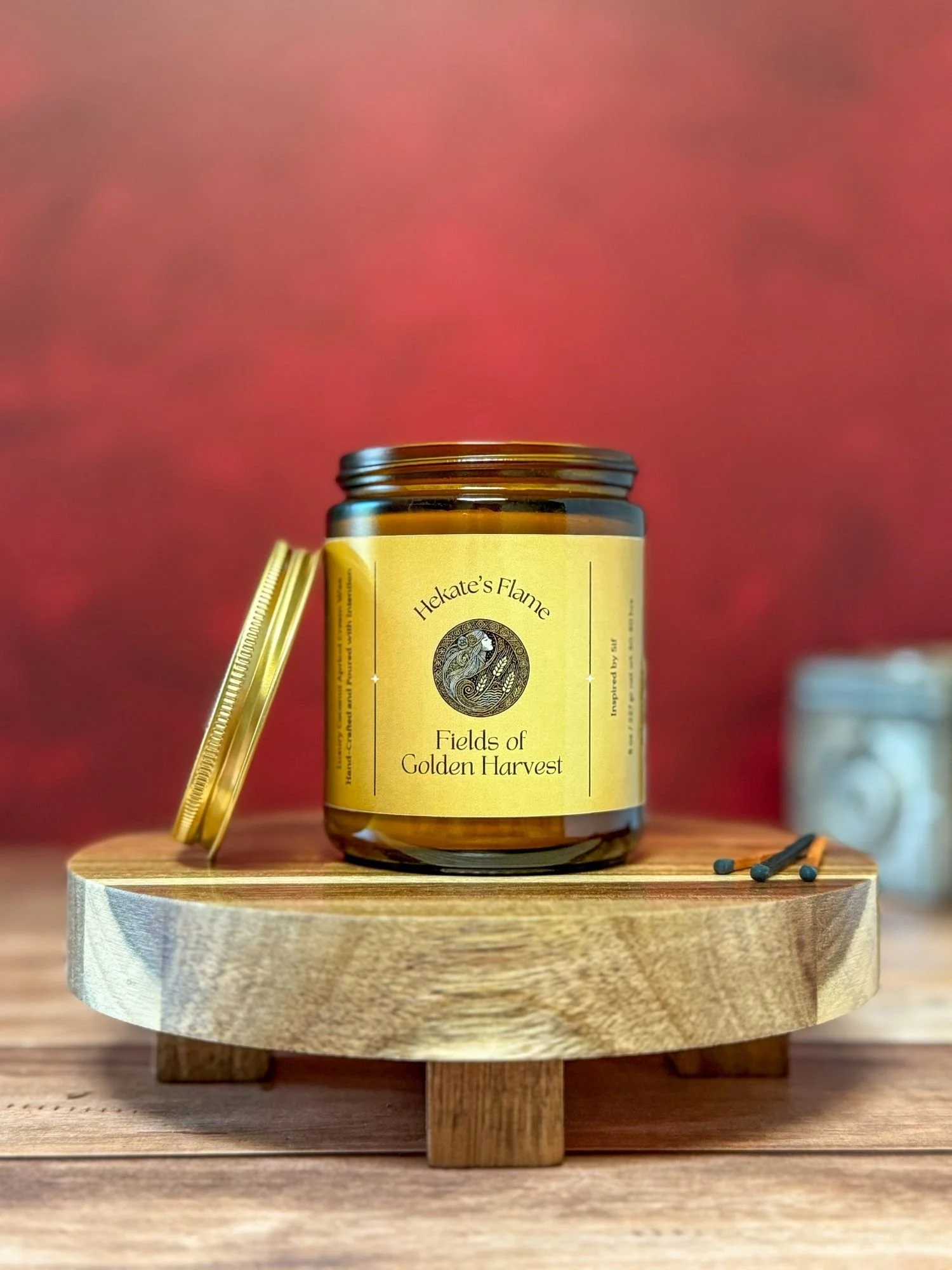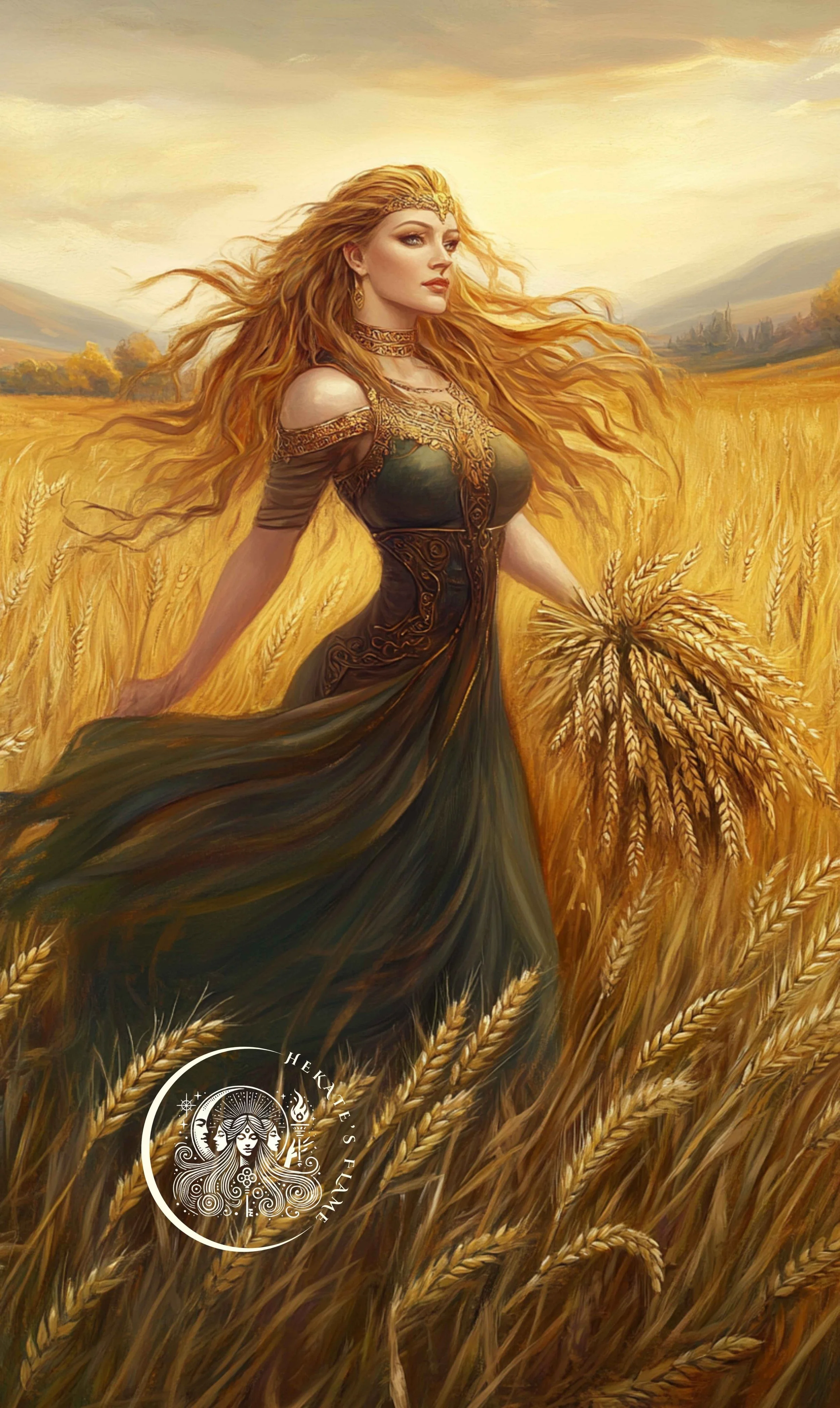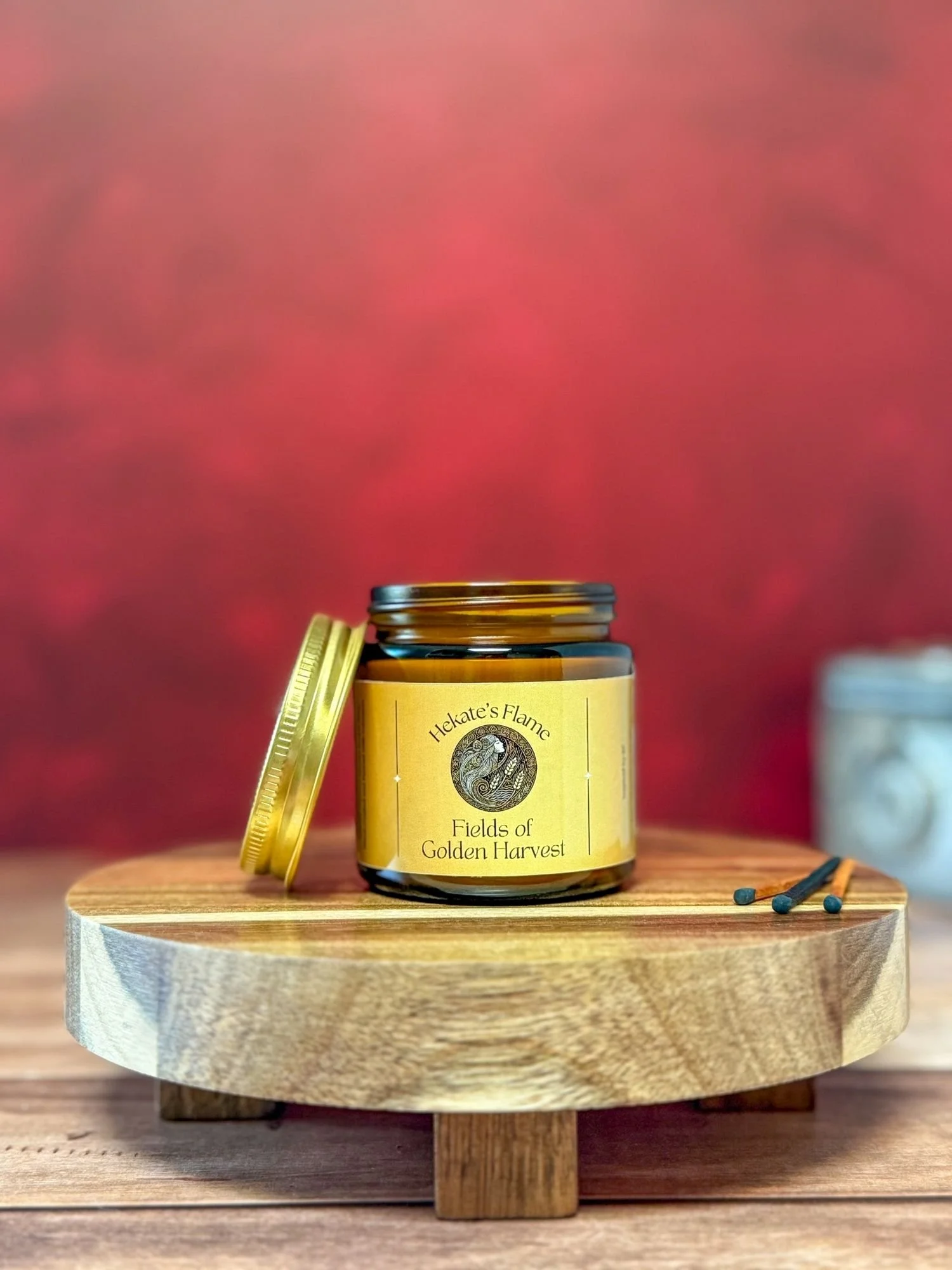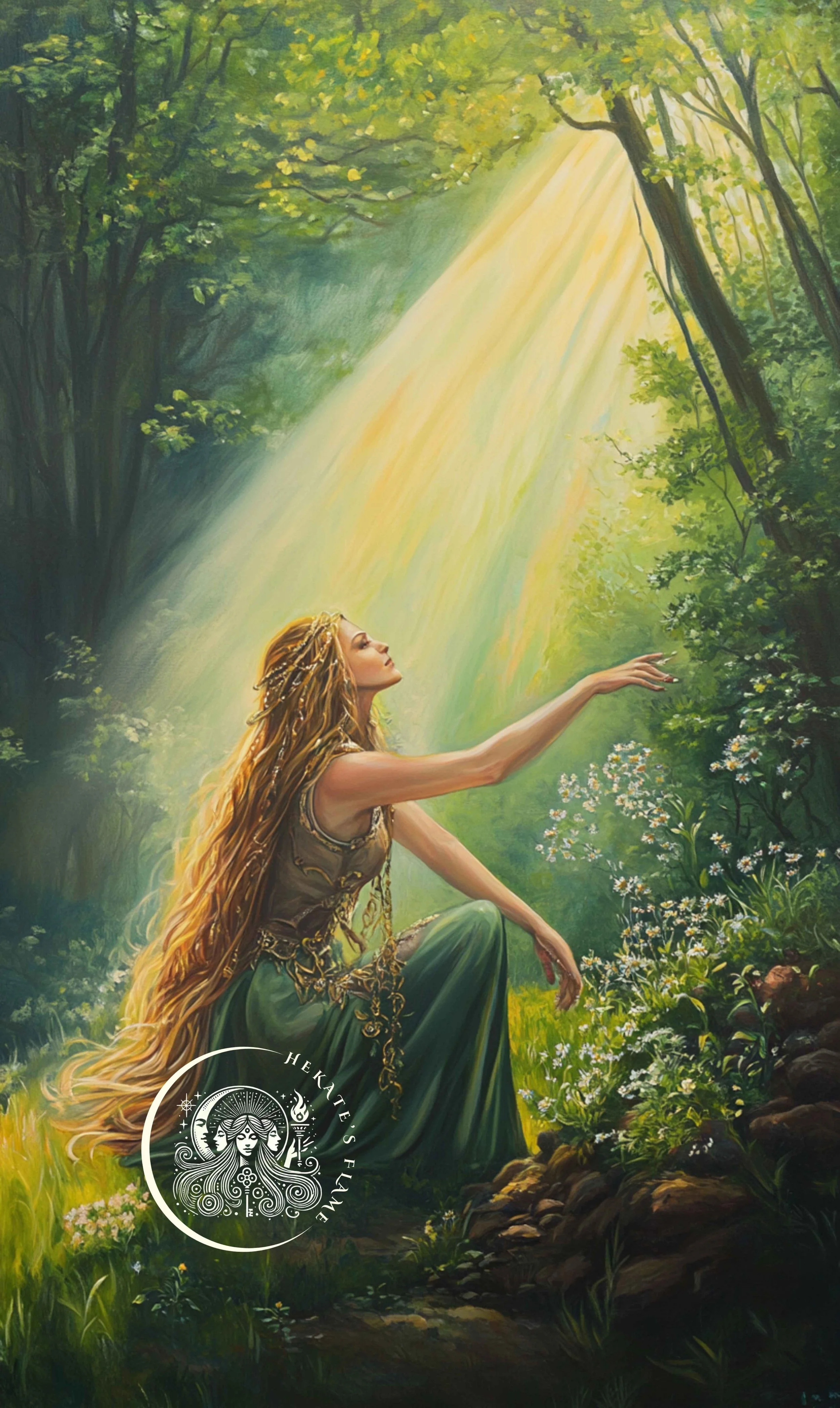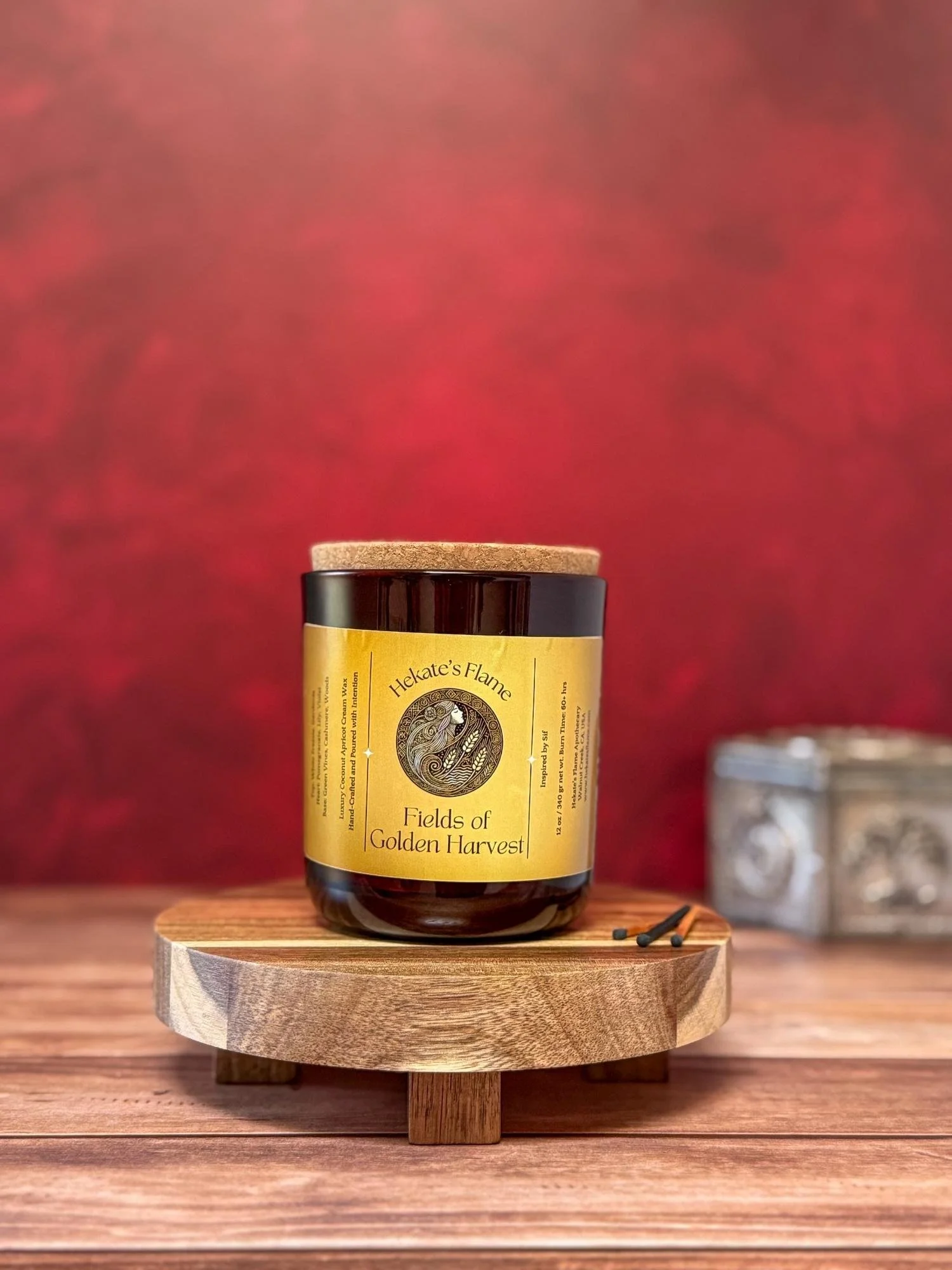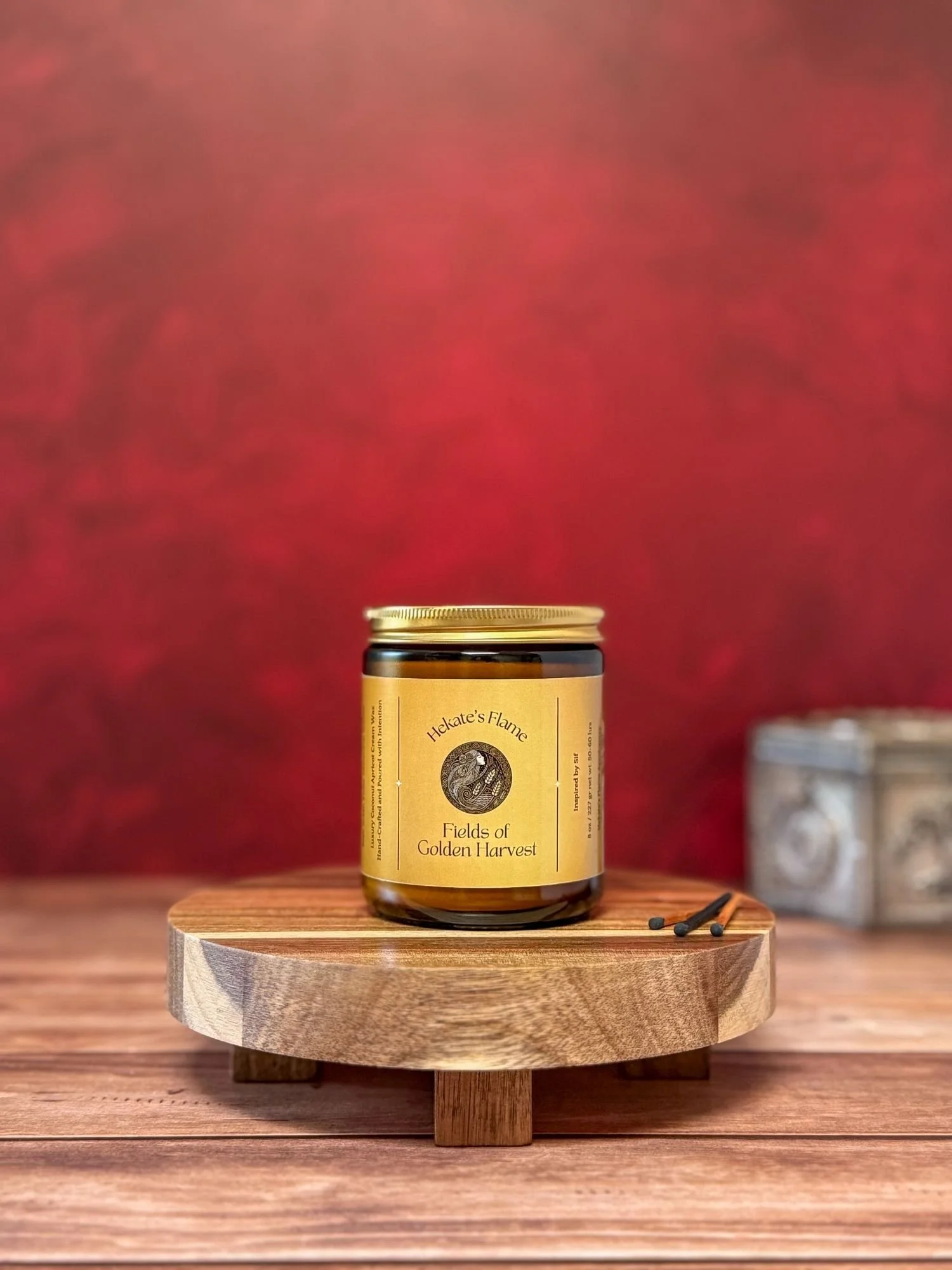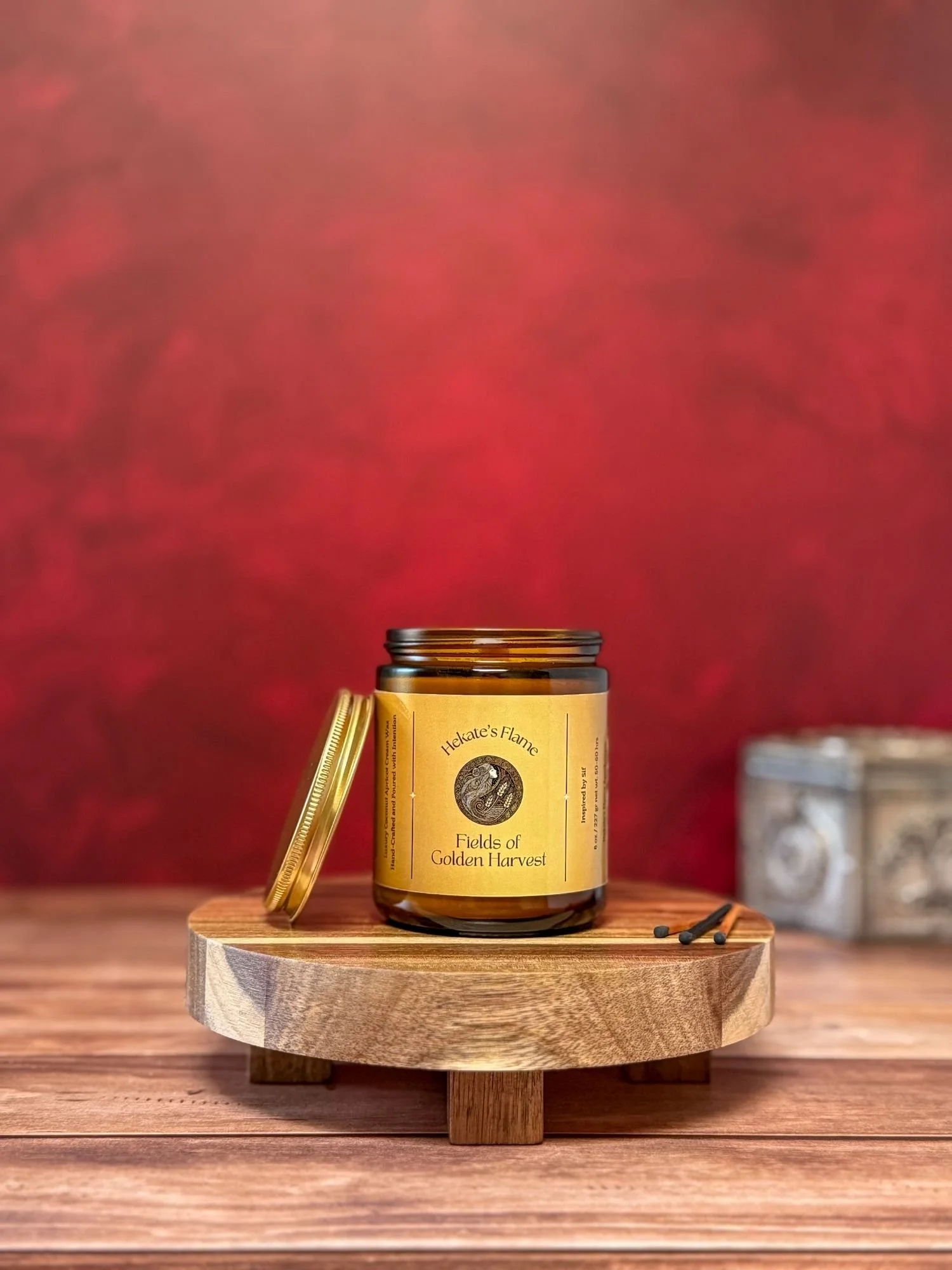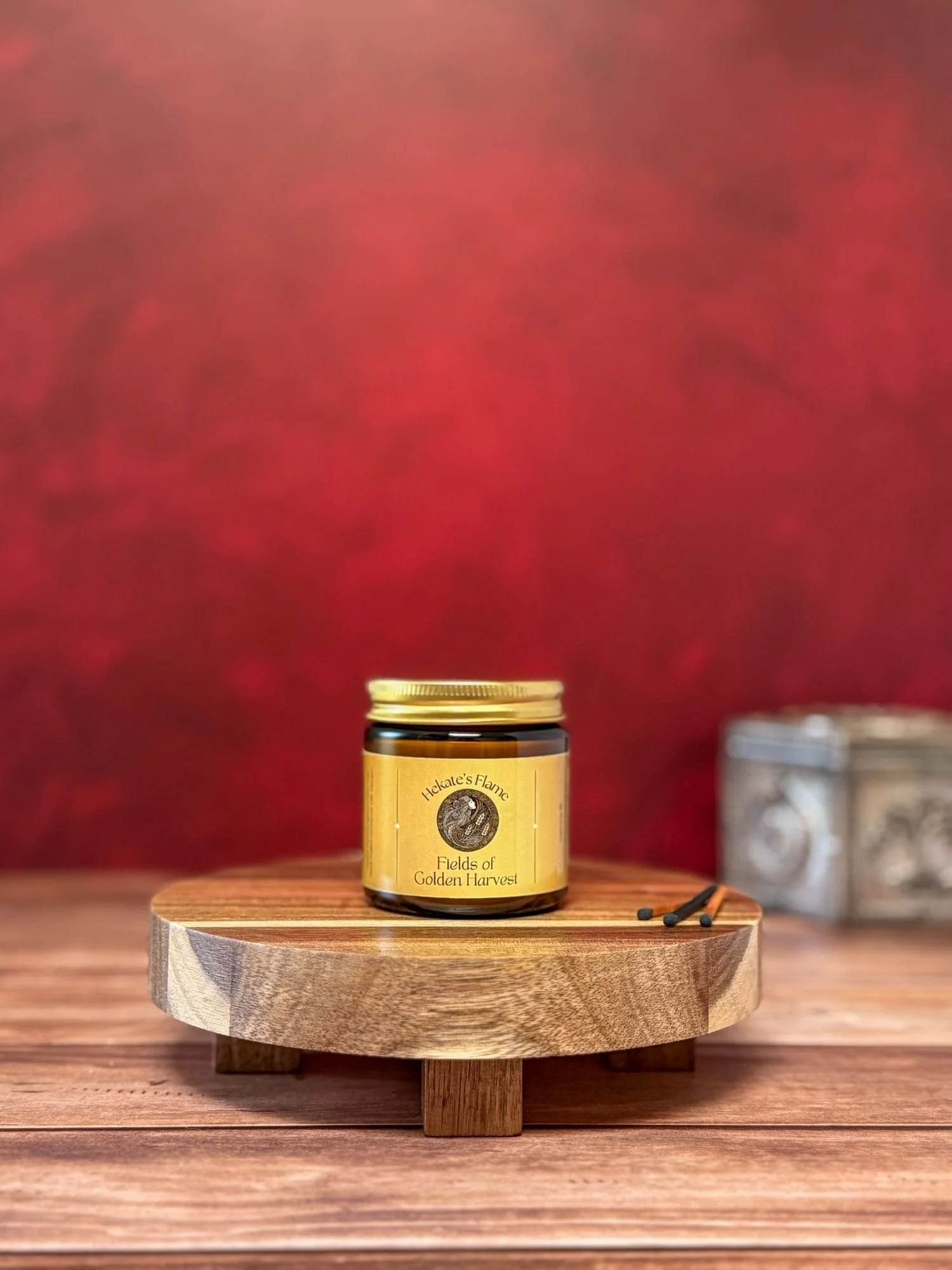‘Fields of Golden Harvest’: A Homemade Artisanal Candle Inspired by Skadi, the Norse Goddess of Winter, Hunting, and the Mountains
She who claims the mountain’s breath and guards the forgotten wilds
Frostveil Peaks is the icy breath of the North: the crisp stillness of snow-covered summits, and the fierce, untamed spirit of Skadi, goddess of winter and the hunt. The scent opens with top notes of ozone, camphor, and citrus, cutting through the air like the first gust of a mountain storm, awakening the senses with the sharp clarity of frost on skin. As it unfolds, the heart reveals a wild contrast: the crisp sweetness of pear and red currant entwined with the resinous whisper of pine, evoking snow-dusted forests where wolves prowl and the echo of a hunter’s bowstring sings through the silence. Beneath it all, the base of juniper and sage weaves a grounding, evergreen foundation, earthy yet wild, like the cold wind rushing through alpine groves, carrying the scent of untouched wilderness and the solitude of the peaks.
Frostveil Peaks is the embodiment of Skadi’s domain: untamed, exhilarating, and fiercely free, where the mountains rise eternal and the frozen wilds bow to no one.
Curious about how the layers of scent unfold? Learn more about scent profiles ~ top, heart, and base notes at this blog post: Scent Profiles, Top, Heart, and Base Notes.
Our candles are lovingly handcrafted in our home studio, Nimue’s Lair, nestled in Walnut Creek, CA. Each one begins with a luxurious blend of coconut-apricot wax, carefully infused with premium fragrance oils. Poured by hand into elegant glass vessels and amber jars, they’re finished with hand-cut labels and enchanted final touches. Every candle is a small ritual, infused with magick, intention, and the quiet glow of story.
-
Scent Notes:
Top: Ozone, Camphor, Citrus
Heart: Pear, Pine, Red Currant, Berry, Cherry Blossom
Base: Juniper, Sage
Seasonal Resonance: Winter’s Chill ❄️🌲
A fragrance as crisp as freshly fallen snow, where frost-laced air carries the scent of towering evergreens and the quiet hush of winter’s embrace. Cool and invigorating, yet subtly bright, this scent captures the season’s pure and refreshing spirit.
🌿 Primary Category: Aromatic & Herbal
Juniper, sage, and pine lend a fresh, herbal complexity, mirroring the crisp air of a snow-covered forest.
🌊 Secondary Category: Marine & Ozonic
Ozone and camphor weave a breezy, invigorating touch, like the sharp clarity of winter air just before a snowfall.
A fragrance that embodies winter’s breath: cool, fresh, and alive with the stillness of the season. ❄️✨
Please visit this blog post for more information on Scent Profiles, Top, Heart, and Base Notes.
-
12 oz Deluxe – Wine Red Aura Glass · Coco Apricot Wax
Burn Time: 60+ hours
Bold and enduring, this candle fills your space with myth and memory. Crafted for spacious sanctuaries, this candle shines in wide-open living rooms, high-ceilinged studios, and sacred hearths ~ places where scent is free to roam and the flame becomes a luminous companion to stillness and story.8 oz Classic – Amber Jar · Coco Apricot Wax
Burn Time: 50–60 hours
A perfect size for quiet corners and thoughtful pauses. Let it warm your reading nook, home office, or bedside altar, where its flame flickers like a whisper of intention.4 oz Petite – Amber Jar · Coco Apricot Wax
Burn Time: 20–25 hours
Small in size, rich in presence. This candle is ideal for travel, gifting, or sanctifying intimate spaces - guest rooms, personal altars, or quiet corners where scent and flame are invited to linger with intention. -
For detailed information about our waxes, wicks, fragrance blends, and vessels, please see our Ingredients & Materials Guide.
-
For guidance on how to tend your flame with care, ensuring the cleanest, safest, and most enchanting burn, please visit our Candle Care Guide.
-
Please visit the Shipping and Returns Information page for details.
-
All photographs, images, and written content on this website are original works of Hekate's Torch Apothecary, LLC (doing business as Hekate’s Flame Apothecary) and are protected by copyright. They may not be used, altered, shared, or reposted on any platform without explicit written consent. All label designs, photos, images, and content are the exclusive property of Hekate's Torch Apothecary, LLC.
For inquiries regarding the use of our content, please contact: care@hekatesflame.com
© 2025 Hekate's Torch Apothecary, LLC. All rights reserved.
Content Warning:
This post explores ancient myths that include themes of violence, including assault and warfare, which may be sensitive for some readers. Please proceed with care and be mindful of your well-being while engaging with these stories.
Skadi: The Untamed Spirit of Winter and Mountains
High in the bleak and silent mountains of Norse mythology, where the wind sculpts snowdrifts into icy spires and shadows linger under a sun that barely rises, a goddess rules with unyielding strength. Skadi, goddess of winter, skiing, and the wilderness, embodies the raw, untamed spirit of Scandinavia's highest peaks. Her story, marked by vengeance and independence, reverberates through the frozen slopes and echoes with the howl of wolves, casting her as both a fierce protector and a vengeful force.
So potent was her influence that even as Christianity spread through Scandinavia, the memory of Skadi endured. For centuries after the gods fell silent, her name was spoken in whispers across the snowbound North, one of the last Norse deities to be honored in rites and remembered by those who saw her spirit in winter's icy grip.
Forged in Ice and Loss: Skadi's Ancestry and Origins
Skadi was born to Thjazi, a formidable giant of Jötunheimr, a realm as wild and unforgiving as winter, where giants, also known as Devourers, roamed as primal forces of nature. From her father, she inherited a love for the high places, where the air is sharp and thin, and the world stretches out in glacial stillness.
Her character, steeped in ancient tongues, hints at "shadow" and "harm," a fitting etymology for one who would carry both darkness and retribution in her heart.
Thjazi's death was the spark that ignited Skadi's journey. When he was killed by the gods for kidnapping the goddess Idunn, who guarded the apples of eternal youth, Skadi felt grief as deep and cold as the winter night. Yet with this sorrow came a fierce resolve rooted in Viking values: honor, reparation, and the demand for justice. She took up her weapons, donned her armor, and made the solitary journey to Asgard, the gods' gleaming realm, her heart set on vengeance. In a world where loyalty to kin demanded unwavering action, her quest for reparation was not only expected but revered, a testament to the Viking spirit of enduring loyalty and unflinching honor in the face of loss.
An Uneasy Truce: Skadi's Demands of the Gods
The gods could see the unyielding resolve in Skadi's gaze; they knew she would not be swayed. Meeting her demands was their only path to peace. Skadi required two things: a husband from among the gods and a moment of joy that could briefly lift her grief. The latter proved a daunting task, for her sorrow was profound, a shadow cast by the death of her only kin.
Loki, ever the trickster, took it upon himself to bring a laugh to her frozen heart. In a display that was as outlandish as it was absurd, he tied his own testicles to a goat. The two opponents, a mischief god and an unamused goat, engaged in a screeching tug-of-war, each yanking and crying out in a contest of nerves and pain. The bizarre scene continued until, with one final wrench, the rope snapped, sending Loki tumbling and landing unceremoniously in Skadi's lap. At that, a reluctant smile cracked the goddess's stern countenance, a fleeting spark of humor in the winter storm of her heart. Through her laughter, the gods glimpsed the depth of her suffering and the iron will that tempered her sorrow.
Her second demand, however, carried a weightier consequence. Blindfolded and asked to choose her husband by the feel of their feet alone, Skadi reached for the most graceful, hoping to select Baldr, the radiant god. But fate had other plans, and she found herself instead bound to Njord, god of the sea, whose essence was as fluid and mutable as hers was cold and constant.
Bound by Frost and Tide: The Marriage of Skadi and Njord
In Njord, Skadi found an unlikely companion, a being of salt and waves whose heart longed for the shore's soft sands and gentle breezes. Where she thrived in the still, quiet expanse of snow and ice, he was drawn to the ever-moving sea, alive with the sounds of seabirds and the crash of waves. Their union was a marriage of opposites, frost and tide, mountain and ocean, each powerful yet irreconcilable.
Njord's family, however, held some familiarity with such unions. His son, Freyr, like his father, was drawn to a jötun, Gerdr, a beautiful giantess whom he would pursue in an unshakable love. Even Freyja, Njord's daughter, embraced kinships that crossed between gods and other realms, her own connections tied to both beauty and power. Like Skadi, they formed bonds across boundaries, reaching between worlds. Yet even this family legacy of mingling realms could not bridge the divide between Skadi and Njord. They alternated between her mountain keep, Thrymheimr, where Njord struggled with the solitude and the chill, and his coastal realm, where Skadi found the light and warmth stifling.
In the end, they parted ways, each accepting the truth that some forces, though strong, cannot merge. Skadi returned to her frosty dominion, carrying within her a new wisdom: that strength sometimes lies not in compromise but in honoring one's true nature.
Queen of the Icy Wilds: Skadi's Realm and Power
In her mountain fortress, Skadi reigned supreme, a lone figure moving through the snow-laden wilderness with unmatched grace. Clad in furs and armed with her bow, she traversed her realm on swift skis, a winter huntress whose presence brought fear and respect. Wolves prowled at her side, their eyes as fierce and cold as hers, and together, they ruled the silent expanse, unchallenged and unbound.
The mountain winds whispered her name, and travelers lost in snowstorms would call upon her for guidance. Known as the "Snowshoe Goddess," Skadi was both a guardian and a peril, a presence that could either lead you to safety or remind you of winter's lethal beauty. In times of blizzards and frost, she was said to appear like a spectral guide through the snow, rescuing those stranded in her frozen domain and leading them through perilous trails to the warmth of shelter. Her dominion was not a place of softness or ease but one of endurance and resilience, a landscape that honored those strong enough to survive its trials.
A Ruthless Justice: Skadi and Loki's Eternal Punishment
Skadi's relationship with the gods was marked by both alliance and caution. Yet among them, none earned her enmity more than Loki, the trickster whose schemes had led to her father's death. Even after her marriage and fragile truce with the Aesir, a bitter shadow lingered, a grief frozen into wrath that refused to melt. In one of the most harrowing tales, Skadi exacts her vengeance by binding Loki beneath a venomous serpent, suspending it above him so that its fangs drip poison onto his face as a slow, eternal torment. Only his wife, Sigyn, spares him brief moments of respite, catching the venom in a bowl; yet, each time she turns to empty it, the poison falls, and Loki writhes in agony, his thrashing shaking the very earth.
But this act, as dark and unyielding as winter, is no ordinary retribution. Skadi's justice does not end with Loki's suffering; it sets in motion the beginning of the end. For one day, the bonds that hold him will break, and Loki, carrying the scars of Skadi's punishment, will rise as a force of destruction. He will lead armies of giants and beasts in a final assault upon the gods, his rage and pain fueling the fires of Ragnarök.
In this relentless act, Skadi embodies a cold, impartial justice as indifferent as the winter's frost. Her vengeance, precise and merciless, is not merely punishment; it is the stirring of fate itself. Skadi wields death as she wields her bow, with an unwavering hand and a steady aim, embracing the stark inevitability of nature's cycles. Ultimately, her wrath is a reminder that even the gods are bound to the wheel of destiny, where justice and ruin often walk hand in hand.
Symbols of a Winter Queen: Skis, Wolves, and the Bow
Skadi's symbols - her skis, bow, and wolves - are extensions of her spirit, reflecting her mastery over the brutal elements. Her skis allowed her to glide effortlessly over the snow, a silent hunter whose tracks were barely visible on the white expanse. Her always-ready bow symbolized her skill in hunting and her readiness to defend her realm and exact justice. Wolves, creatures of loyalty yet unbounded by society, mirrored her fierce independence.
These symbols also connected her to the mortal world, especially to those who depended on the winter landscape for survival. Hunters, skiers, and travelers of the Scandinavian mountains saw her as both an ancestor and a guide, a figure who walked the same snow-laden paths bound to the same unforgiving landscape. Each turn of a ski, each step in the snow, was an echo of her presence, an invocation of her strength.
Reflections in Myth: Skadi and the Wild Woman Archetype
Skadi's image reverberates across mythologies, drawing parallels to figures like Artemis, the Greek goddess of the hunt. Both embody the untamed spirit of nature and represent an archetype of feminine independence, embracing lives unbound by conventional ties. Yet, while Artemis presides over forests bathed in warm Mediterranean sunlight, Skadi reigns over the harsh, frozen expanse of Nordic mountains, each goddess mirroring her land's temperament.
With her nimble agility and youthful grace, Artemis is a guardian of the wild, often accompanied by deer and woodland creatures, symbols of her domain's gentler aspects. She embodies a sense of harmony within nature, her power expressed through protection rather than dominance. In contrast, Skadi is defined by resilience, a huntress who thrives amid the unyielding cold, and her companion wolves, whose fierce loyalty and adaptability reflect the unforgiving winter landscape. Where Artemis protects life, Skadi celebrates survival; her world rewards strength and endurance.
These cultural distinctions reveal a shared yet divergent vision of the wild woman archetype. Both goddesses are fierce, autonomous figures who answer only to themselves. Artemis's grace and poise resonate with the Mediterranean ideal of balanced beauty, while Skadi's power is that of the Nordic wilderness: raw, relentless, and untamed. In this way, Skadi's story is not simply one of vengeance and marriage but of selfhood, a tale of a woman unafraid to claim her place within a world defined by gods, men, and the elements alike.
Skadi and Ullr: Divine Companions of the Winter Hunt
Mythology hints at a powerful connection between Skadi and Ullr, the god of skiing and winter hunting. Though much of their relationship is left to the imagination, their shared mastery of snowbound landscapes and winter skills suggests a kinship that might extend beyond mere companionship. Some theories propose that Ullr and Skadi were once worshipped as a divine pair or perhaps even as aspects of the same winter deity, embodying a seamless union of skills needed to survive the unforgiving season. Ullr, like Skadi, represents the strength, precision, and resilience required to navigate winter's trials, and together, they form a duo that celebrates the winter landscape in all its raw beauty and peril.
In their roles as guardians of the frozen wilderness, Ullr and Skadi echo each other's virtues: strength, independence, and the courage to face nature's harshest tests. Whether worshipped as complementary deities or one powerful entity later split in myth, their shared domain reflects Norse culture's reverence for the skills and endurance demanded by winter. In them, the Norse saw the enduring virtues needed to face the season's challenges without flinching.
Skadi's Legacy: The Spirit of Winter's Solitude
Today, Skadi's story remains a testament to the resilience required to endure solitude and hardship. She is the spirit that haunts the mountains, the whisper of the wind through snow-covered pines, the feeling of freedom on a crisp winter morning. Her legacy lives on in tales and the hearts of those who seek the thrill of the winter wilderness, who feel at home on skis and find solace in the silence of snow.
In Skadi, we see the embodiment of winter's beauty and danger. She is reminder that the wild is not something to be tamed but something to be respected.
She endures as a symbol of self-reliance and fierce autonomy, a goddess whose power lies not in submission or compromise but in her unwavering commitment to her own path. She is winter's heart, fierce and untouchable, guiding those who dare to venture into her realm.
References:
Cavendish, R. (1970). Man, myth and magic: an illustrated encyclopedia of the supernatural. Marshall Cavendish Corporation.
Illes, J. (2010). Encyclopedia of spirits: The ultimate guide to the magic of fairies, genies, demons, ghosts, gods & goddesses. Harper Collins.
Littleton, C. S. (2002). Mythology: the illustrated anthology of world myth & storytelling. Duncan Baird.
McCoy, D. (n.d.). Skadi. Norse Mythology for Smart People. https://norse-mythology.org/gods-and-creatures/giants/skadi/
McCoy, D. (2016). The Viking spirit: An introduction to Norse mythology and religion. CreateSpace Independent Publishing Platform.
Now Skadi, the daughter of the giant Thjazi, took helm and birnie and all weapons of war and proceeded to Ásgard, to avenge her father. The Æsir, however, offered her reconciliation and atonement: the first article was that she should choose for herself a husband from among the Æsir and choose by the feet only, seeing no more of him. Then she saw the feet of one man, passing fair, and said: "I choose this one: in Baldr little can be loathly." But that was Njördr of Nóatún.



























































































